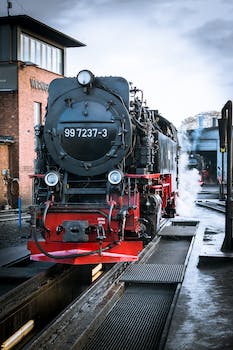

-
Table of Contents
Unleashing the Power of Steam: Revolutionizing History
Introduction
The steam engine is a revolutionary invention that has played a significant role in shaping the course of human history. Developed in the 18th century, it harnessed the power of steam to drive machinery and revolutionize various industries. This invention marked a pivotal moment in the Industrial Revolution, transforming transportation, manufacturing, and agriculture. The steam engine's impact was far-reaching, enabling the expansion of railways, powering factories, and facilitating the growth of global trade. Its influence extended well beyond its initial invention, paving the way for modern technologies and shaping the world we live in today.
The Invention and Evolution of the Steam Engine
The steam engine is a remarkable invention that has played a significant role in shaping the modern world. Its invention and subsequent evolution have revolutionized transportation, industry, and even the way we live our lives. The steam engine, which harnesses the power of steam, has a rich history that dates back centuries.
The invention of the steam engine is credited to Thomas Newcomen, an English engineer, in the early 18th century. Newcomen's steam engine was primarily used to pump water out of mines, a task that was previously done by manual labor. This invention marked a significant advancement in mining technology and greatly increased productivity.
However, it was James Watt, a Scottish engineer, who made the most significant improvements to the steam engine. In the late 18th century, Watt developed a separate condenser that greatly increased the engine's efficiency. This innovation allowed the engine to use less fuel and produce more power, making it suitable for a wide range of applications.
With Watt's improvements, the steam engine quickly found its way into various industries. It was used to power textile mills, allowing for the mass production of textiles and fueling the Industrial Revolution. The steam engine also revolutionized transportation with the development of steam-powered locomotives and steamships. These advancements made travel faster and more efficient, connecting distant places and facilitating trade and commerce.
The steam engine continued to evolve throughout the 19th century. Engineers made further improvements to increase its power and efficiency. One notable development was the introduction of the high-pressure steam engine by Richard Trevithick. This engine operated at higher pressures, allowing for even greater power output.
Another significant advancement came with the introduction of the steam turbine by Charles Parsons in the late 19th century. The steam turbine was a more efficient and compact alternative to the traditional reciprocating steam engine. It found widespread use in power generation, propelling ships, and even in aircraft.
The steam engine's impact on society cannot be overstated. It transformed the world by powering the Industrial Revolution and driving economic growth. It enabled the mass production of goods, leading to increased prosperity and a higher standard of living for many. The steam engine also played a crucial role in the expansion of railways, connecting people and goods across vast distances.
While the steam engine has been largely replaced by more advanced technologies, its legacy lives on. It paved the way for the development of other forms of power generation, such as internal combustion engines and electric motors. The principles behind the steam engine, harnessing the power of steam, continue to be used in various applications today.
In conclusion, the invention and evolution of the steam engine have had a profound impact on human history. From its humble beginnings as a water-pumping device, the steam engine transformed industries, transportation, and society as a whole. Its advancements, made by engineers like James Watt and Richard Trevithick, propelled the Industrial Revolution and shaped the modern world. While the steam engine may no longer be at the forefront of technology, its contributions and legacy are undeniable.
The Impact of the Steam Engine on Industrialization

The steam engine is widely regarded as one of the most important inventions in human history. Its impact on industrialization cannot be overstated. The steam engine revolutionized transportation, manufacturing, and agriculture, paving the way for the modern world we live in today.
Before the steam engine, human and animal power were the primary sources of energy. This limited the scale and efficiency of production. However, with the invention of the steam engine, a new era began. The steam engine harnessed the power of steam to generate mechanical energy, which could be used to drive machinery and perform work.
One of the key areas where the steam engine had a profound impact was transportation. Prior to its invention, transportation was slow and expensive. Goods had to be transported by horse-drawn carts or ships, which were limited by the speed and endurance of the animals. However, with the steam engine, trains and steamships became a reality. These new modes of transportation were faster, more efficient, and could carry larger loads. This led to the expansion of trade and the growth of cities, as goods could be transported more quickly and at a lower cost.
The steam engine also revolutionized manufacturing. Before its invention, manufacturing was largely done by hand, with skilled craftsmen producing goods one at a time. However, with the steam engine, factories could be powered by steam, allowing for the mass production of goods. This led to the development of the factory system, where workers specialized in specific tasks and worked together to produce goods on a large scale. This increased productivity and lowered the cost of goods, making them more affordable and accessible to a wider range of people.
Agriculture was another area where the steam engine had a significant impact. Before its invention, agriculture was labor-intensive and relied on human and animal power. However, with the steam engine, agricultural machinery such as steam-powered tractors and threshing machines became possible. These machines increased the efficiency of farming, allowing for larger-scale production and higher yields. This led to a surplus of food, which in turn supported the growing population and fueled further industrialization.
The impact of the steam engine on industrialization was not limited to transportation, manufacturing, and agriculture. It also had far-reaching social and economic consequences. The steam engine created new job opportunities, as workers were needed to operate and maintain the machinery. This led to the growth of cities and the rise of the working class. It also contributed to the rise of capitalism, as the increased productivity and lower cost of goods created new opportunities for entrepreneurs and investors.
In conclusion, the steam engine had a profound impact on industrialization. It revolutionized transportation, manufacturing, and agriculture, paving the way for the modern world we live in today. The steam engine transformed the way goods were produced and transported, leading to increased productivity, lower costs, and the growth of cities. It also had far-reaching social and economic consequences, creating new job opportunities and contributing to the rise of capitalism. The steam engine truly harnessed the power of steam and changed the course of history.
The Legacy of the Steam Engine in Modern Technology
The steam engine, one of the most significant inventions in human history, has left an indelible mark on modern technology. Although it was first developed in the 18th century, its legacy continues to shape our world today. From transportation to manufacturing, the steam engine revolutionized various industries and paved the way for the advancements we enjoy today.
One of the most notable areas where the steam engine has had a lasting impact is transportation. Prior to its invention, travel was limited to the speed of horses or the wind. However, with the advent of steam-powered locomotives, the world suddenly became more accessible. Trains could now transport goods and people at unprecedented speeds, connecting cities and countries like never before. This revolution in transportation not only facilitated trade and commerce but also brought people closer together, fostering cultural exchange and economic growth.
In addition to revolutionizing transportation, the steam engine also played a crucial role in the development of manufacturing. Before its invention, factories relied on manual labor and water-powered machinery, which had limitations in terms of efficiency and productivity. However, with the introduction of steam-powered engines, factories could now operate at a much larger scale. The steam engine provided a reliable and consistent source of power, enabling factories to increase production and meet the growing demands of the industrial revolution. This led to the mass production of goods, lower costs, and ultimately, the rise of consumerism.
Furthermore, the steam engine's impact extended beyond transportation and manufacturing. It also played a vital role in the development of electricity generation. Steam turbines, a variation of the steam engine, became the backbone of power plants, converting thermal energy into mechanical energy, which in turn generated electricity. This breakthrough allowed for the widespread distribution of electricity, transforming the way we live and work. From lighting our homes to powering our appliances, electricity has become an essential part of our daily lives, all thanks to the steam engine's contribution to power generation.
Moreover, the steam engine's legacy can be seen in the field of engineering. The principles and mechanisms behind the steam engine laid the foundation for modern engineering practices. Engineers learned valuable lessons about thermodynamics, mechanics, and efficiency through their work with steam engines. These lessons continue to shape the design and development of modern engines, such as internal combustion engines and turbines. The steam engine's influence on engineering is a testament to its enduring impact on technological advancements.
In conclusion, the steam engine's legacy in modern technology is undeniable. Its impact on transportation, manufacturing, power generation, and engineering has shaped the world we live in today. From the industrial revolution to the digital age, the steam engine's contributions continue to be felt. As we marvel at the advancements of modern technology, it is important to recognize the role that the steam engine played in laying the foundation for these innovations. The steam engine truly harnessed the power of steam throughout history and left an indelible mark on our world.
Q&A
1. When was the steam engine invented?
The steam engine was invented in the late 17th century, with Thomas Savery and Thomas Newcomen being credited as the early pioneers.
2. How did the steam engine revolutionize transportation?
The steam engine revolutionized transportation by powering locomotives and steamships, enabling faster and more efficient travel over long distances.
3. What were some key advancements in steam engine technology?
Key advancements in steam engine technology include James Watt's improvements in the late 18th century, which increased efficiency and reliability, and the development of high-pressure steam engines in the 19th century.
Conclusion
In conclusion, the steam engine has played a significant role in harnessing the power of steam throughout history. Its invention in the 18th century revolutionized various industries, including transportation, manufacturing, and agriculture. The steam engine enabled the development of steamships, locomotives, and factories, leading to increased productivity and economic growth. Although its prominence has diminished with the advent of more advanced technologies, the steam engine remains a crucial milestone in the history of human innovation and the utilization of steam power.











